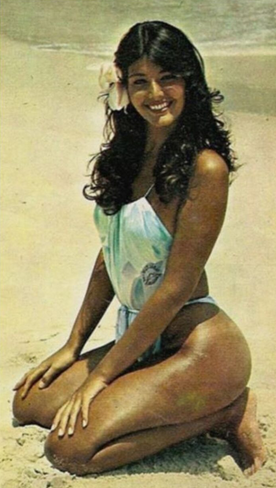October 24, 2024 Artistic eroticism, Gender Identity
All of which meant that she became independent in her early years.
Roberta Close, a very special beauty
In brief
She had her first major film role in 1985 in the comedy Si tu vas a Rio … tu muers, which made her a star in Brazil.
She was the first transsexual model to pose nude for the Brazilian edition of Playboy.
She defied Brazilian laws that prevented her from using her usual name, Luíza Gambine Moreira, or declaring her gender on official documents, and took her case to the Brazilian Supreme Court, which finally ruled in 2005.
In 1999 she was arrested (in Brazil) for using a passport with her “forbidden” identity.

She has been living in Switzerland since 1997.
Roberta Close and her husband Roland Granacher, a Swiss businessman, separated after seven years of marriage, apparently because of Close’s highly publicised romantic exploits (before marriage) with other celebrities (Robert de Niro, George Clooney, Eddie Murphy).
They reconciled years later.

She adopted the pseudonym Roberta Close after being represented by an entertainment agency (run by her future husband).
The artistic surname “Close” comes from the now defunct Close magazine, for which Roberta posed in 1981, making her a national celebrity in Brazil and selling more than ten million copies.
Although she was happy with who she was, in 1989, under pressure from her agency, she underwent a sex change operation at the Charing Cross Clinic in London. After her recovery, she appeared in an extensive photoshoot for the Brazilian men’s magazine Sexy, and was later voted “Brazil’s Most Beautiful Woman” by readers.
At the age of 18, she appeared for military conscription wearing an evening gown.
She was exempted, but her father, an army officer, disowned her forever.
Biography
Childhood and adolescence
The youngest of three siblings from a middle-class family in the Bairro de Fátima district of Rio de Janeiro, she faced the prejudice of her entire family when she decided to publicly embrace her female gender identity.
Out of shame, her father told friends that the woman in the house was his maid, not his daughter.
All of this led the young woman to become independent at an early age.
At the age of fourteen, she decided to leave her family and move in with her grandmother, tired of being subjected to her parents’ aggression and prejudice.
Career as a model
In 1980, when she was 16 years old, she was walking down a street in Copacabana when Guilherme Araújo and Caetano Veloso drove by, stopped and came to talk to her.
Guilherme said he liked her a lot and asked her to join his agency.
As she had always wanted to be famous, her striking beauty as a six-foot tall, black-eyed brunette, who naturally attracted a lot of attention wherever she went, helped her get a modelling job in one of her first attempts to send her CV to agencies.
After a while, she began receiving invitations to work as a presenter.
She went back to school and took drama and music classes, and became very successful in her career as an actress and singer.
At this point, she struck out on her own and continued to appear on the covers of magazines in Brazil and around the world, travelling to different countries to model for the world’s most prestigious brands, becoming a top model in the process.
In the 1980s and 1990s, Roberta Close appeared in the main interview programmes of the Brazilian media : Fantástico, Domingão do Faustão, Hebe, Gugu, in the programmes of Goulart de Andrade, among others.
She later stated in interviews that she had suffered prejudice in soap operas during registration because no men wanted to kiss her character because of her gender identity.
The surgery
In 1989, after ten years of counselling, she underwent sex reassignment surgery.
Immediately after the operation, in 1990, she began to fight for the right to change her name, but her request was immediately rejected.
She attempted to change her name again in 1992, when she obtained permission from the 8th Family Court of Rio to change her identity documents, a request that was denied in the second instance by the TJ-RJ.
In 1997, the model’s defence team filed another lawsuit seeking recognition of her female physical characteristics.
Roberta was then examined by nine medical specialists, whose reports proved beyond doubt that she had female hormonal characteristics.
After decades of legal battles, it was not until 2005, fifteen years after her first legal attempt, that Roberta Close finally won the right to change her name.
In the ruling of the 9th Family Court, based on the opinion of medical experts, the judge wrote that “the progress of science must be accompanied by law, since man creates, applies and is subject to the legal norm, from the most antiquated and obsolete to the most advanced and visionary”.
Although this decision marked a significant change in her life, the newspaper the Último Segundo revealed shortly after the ruling that Roberta Close, although happy, feared that the court’s decision might change again in the future.
The move to Switzerland
Close has been married to Swiss businessman Roland Granacher since 1988.
In 1990 she decided to give up her career as an artist and move with her husband to Zurich, Switzerland.














